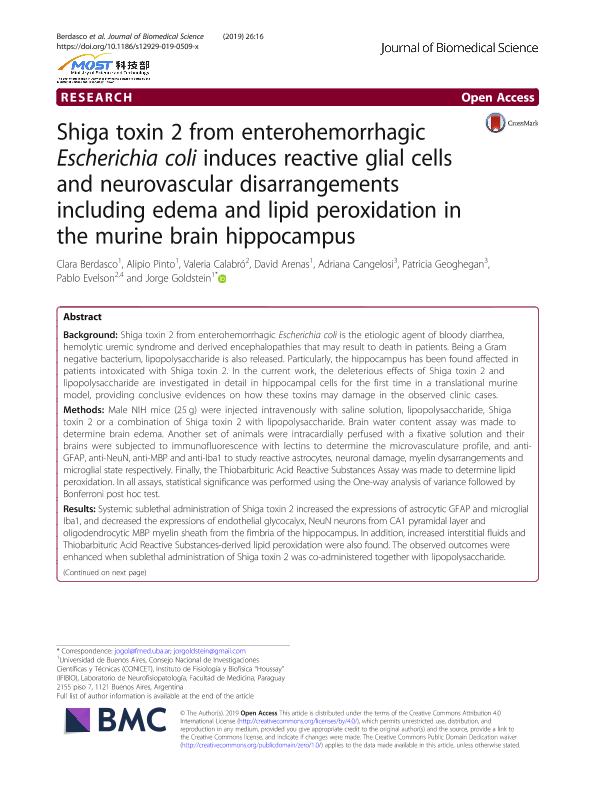Artículo
Shiga toxin 2 from enterohemorrhagic Escherichia coli induces reactive glial cells and neurovascular disarrangements including edema and lipid peroxidation in the murine brain hippocampus
Berdasco, Clara Valentina ; Vasconcelos Esteves Pinto, Alipio
; Vasconcelos Esteves Pinto, Alipio ; Calabró López, María Valeria
; Calabró López, María Valeria ; Arenas Mosquera, David
; Arenas Mosquera, David ; Cangelosi, Adriana; Geoghegan, Patricia; Evelson, Pablo Andrés
; Cangelosi, Adriana; Geoghegan, Patricia; Evelson, Pablo Andrés ; Goldstein Raij, Jorge
; Goldstein Raij, Jorge
 ; Vasconcelos Esteves Pinto, Alipio
; Vasconcelos Esteves Pinto, Alipio ; Calabró López, María Valeria
; Calabró López, María Valeria ; Arenas Mosquera, David
; Arenas Mosquera, David ; Cangelosi, Adriana; Geoghegan, Patricia; Evelson, Pablo Andrés
; Cangelosi, Adriana; Geoghegan, Patricia; Evelson, Pablo Andrés ; Goldstein Raij, Jorge
; Goldstein Raij, Jorge
Fecha de publicación:
02/2019
Editorial:
BioMed Central
Revista:
Journal Of Biomedical Science
ISSN:
1021-7770
Idioma:
Inglés
Tipo de recurso:
Artículo publicado
Clasificación temática:
Resumen
Background: Shiga toxin 2 from enterohemorrhagic Escherichia coli is the etiologic agent of bloody diarrhea, hemolytic uremic syndrome and derived encephalopathies that may result to death in patients. Being a Gram negative bacterium, lipopolysaccharide is also released. Particularly, the hippocampus has been found affected in patients intoxicated with Shiga toxin 2. In the current work, the deleterious effects of Shiga toxin 2 and lipopolysaccharide are investigated in detail in hippocampal cells for the first time in a translational murine model, providing conclusive evidences on how these toxins may damage in the observed clinic cases. Methods: Male NIH mice (25 g) were injected intravenously with saline solution, lipopolysaccharide, Shiga toxin 2 or a combination of Shiga toxin 2 with lipopolysaccharide. Brain water content assay was made to determine brain edema. Another set of animals were intracardially perfused with a fixative solution and their brains were subjected to immunofluorescence with lectins to determine the microvasculature profile, and anti-GFAP, anti-NeuN, anti-MBP and anti-Iba1 to study reactive astrocytes, neuronal damage, myelin dysarrangements and microglial state respectively. Finally, the Thiobarbituric Acid Reactive Substances Assay was made to determine lipid peroxidation. In all assays, statistical significance was performed using the One-way analysis of variance followed by Bonferroni post hoc test. Results: Systemic sublethal administration of Shiga toxin 2 increased the expressions of astrocytic GFAP and microglial Iba1, and decreased the expressions of endothelial glycocalyx, NeuN neurons from CA1 pyramidal layer and oligodendrocytic MBP myelin sheath from the fimbria of the hippocampus. In addition, increased interstitial fluids and Thiobarbituric Acid Reactive Substances-derived lipid peroxidation were also found. The observed outcomes were enhanced when sublethal administration of Shiga toxin 2 was co-administered together with lipopolysaccharide. Conclusion: Systemic sublethal administration of Shiga toxin 2 produced a deterioration of the cells that integrate the vascular unit displaying astrocytic and microglial reactive profiles, while edema and lipid peroxidation were also observed. The contribution of lipopolysaccharide to pathogenicity caused by Shiga toxin 2 resulted to enhance the observed hippocampal damage.
Palabras clave:
ENCEPHALOPATHY
,
HIPPOCAMPUS
,
HUS
,
INFLAMMATION
,
LIPID PEROXIDATION
Archivos asociados
Licencia
Identificadores
Colecciones
Articulos(IBIMOL)
Articulos de INSTITUTO DE BIOQUIMICA Y MEDICINA MOLECULAR
Articulos de INSTITUTO DE BIOQUIMICA Y MEDICINA MOLECULAR
Articulos(IFIBIO HOUSSAY)
Articulos de INSTITUTO DE FISIOLOGIA Y BIOFISICA BERNARDO HOUSSAY
Articulos de INSTITUTO DE FISIOLOGIA Y BIOFISICA BERNARDO HOUSSAY
Citación
Berdasco, Clara Valentina; Vasconcelos Esteves Pinto, Alipio; Calabró López, María Valeria; Arenas Mosquera, David; Cangelosi, Adriana; et al.; Shiga toxin 2 from enterohemorrhagic Escherichia coli induces reactive glial cells and neurovascular disarrangements including edema and lipid peroxidation in the murine brain hippocampus; BioMed Central; Journal Of Biomedical Science; 26; 1; 2-2019; 1-12
Compartir
Altmétricas



